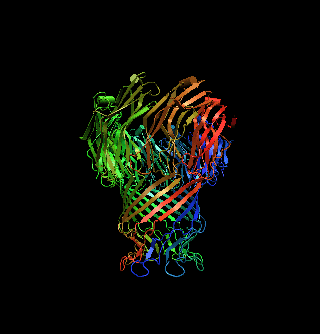A couple of structures
 |
| The mycobacterial porin |
|
|
Movie of the structural changes during a catalytic cycle of nucleoside monophosphate kinasesClemens Vonrhein, G. J. Schlauderer and Georg E. Schulz (1995). Structure 3, 483-490 There are 17 crystal structures of nucleoside monophosphate kinases known. As expected for kinases, they show large conformational changes upon binding of substrates. These are concentrated in two chain segments, or domains, of 30 and 38 residues that are involved in binding of the substrates N1TP and N2MP (nucleoside tri- and monophosphates with bases N1 and N2), respectively. After aligning the 17 structures on the main parts of their polypeptide chains, two domains in various conformational states were revealed. These states were caused by bound substrate (or analogues) and by crystal-packing forces, and ranged between a 'closed' conformation and a less well defined 'open' conformation. The structures were visually sorted yielding an approximately evenly spaced series of domain states that outlines the closing motions when the substrates bind. The packing forces in the crystals are weak, leaving the natural domain trajectories essentially intact. Packing is necessary, however, to produce stable intermediates. The ordered experimental structures were then recorded as still pictures of a movie and animated to represent the motions of the molecule during a catalytic cycle. The motions were smoothed out by adding interpolated structures to the observed ones. Given the proliferating number of homologous proteins known to exist in different conformational states, it is becoming possible to outline the motions of chain segments and combine them into a movie, which can then represent protein action much more effectively than static pictures alone are able to do. For further information and movie downloads Enter Here |